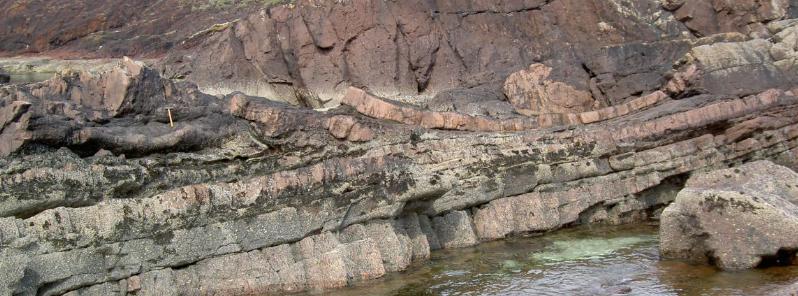Scientists find largest meteorite impact crater in the British Isles

Researchers have located the epicenter of an ancient meteorite impact along the Scottish coast, the largest impact in the British Isles.
In a paper published in Journal of the Geological Society, a team led by Dr. Ken Amor from the Department of Earth Sciences at Oxford University, show how they have identified the crater location 15 – 20 km (9.3 – 12.4 miles) west of a remote part of the Scottish coastline. It is buried beneath both water and younger rocks in the Minch Basin.
The evidence of the impact was first identified in 2008 near Ullapool, Scotland, but then, scientists were unable to pin down the exact location of the crater. Over the last decade, researchers conducted field studies and analyzed rock samples in the lab. Their findings allowed them to identify the meteorite's exact point of impact.
The ancient crater is located roughly 16 km (10 miles) inland from a remote section of the Scottish coast. Buried beneath layers of new rock and water in Minch Basin, the 40 km (25 miles) wide crater has been preserved for 1.2 billion years.
"The material excavated during a giant meteorite impact is rarely preserved on Earth because it is rapidly eroded, so this is a really exciting discovery," Ken Amor, a geologist at the University of Oxford, said in a news release. "It was purely by chance this one landed in an ancient rift valley where fresh sediment quickly covered the debris to preserve it."
Identifying the meteorite's crater, scientists examined the pattern of excavated debris, as well as the magnetic alignment of ancient meteorite particles. The direction of the debris helped scientists track down the likely source of molten shrapnel.
"It would have been quite a spectacle when this large meteorite struck a barren landscape, spreading dust and rock debris over a wide area," Amor said.
Because most ancient impacts are eroded, buried or erased by plate tectonics, scientists don't have a good sense of how often large meteorites impact Earth. Most studies suggest the impact rate was greater when Earth was younger and there was more debris circulating in the solar system.
Scientists plan to continue surveying the region in order to more precisely characterize the nature of the ancient collision.
"The next step will be a detailed geophysical survey in our target area of the Minch Basin," Amor said.
Reference:
"The Mesoproterozoic Stac Fada proximal ejecta blanket, NW Scotland: constraints on crater location from field observations, anisotropy of magnetic susceptibility, petrography, and geochemistry" – Kenneth Amor et al. – Journal of the Geological Society, https://doi.org/10.1144/jgs2018-093
Abstract
The Stac Fada Member of the Mesoproterozoic Stoer Group (Torridon Supergroup) in NW Scotland is a proximal ejecta blanket surrounding an unidentified asteroid impact crater. A combination of field observations of the ejecta deposit and underlying strata, the geographical distribution of terrane-identified basement clasts found embedded in the impactite, and anisotropy of magnetic susceptibility of the impact melt rocks at different locations, can constrain the crater location to be about 15-20 km WNW of Enard Bay and thus buried under Mesozoic sediments in The Minch. Syn-compressional structures within the suevite at Stattic Point give a clear indication of a south-easterly direction of mass motion. The signatures of two different terranes within the Lewisian gneiss help identify the origin of clasts found in the impactite at three locations. These clasts are un-shocked and interpreted as having been swept up by the density current post-impact; their geographic distribution provides an important clue to ejecta emplacement pathways crossing the Assynt and Gruinard terranes. Anisotropy of magnetic susceptibility is used to measure flow direction in pyroclastic density current deposits and is applied here to derive a direction of motion for the impactoclastic density current. It provides good agreement with the other independent methods.
Featured image: University of Oxford

Fascinating stuff! Although I probably won’t have time to track down the Minch Basin, I will be in Scotland later this year and spending some time on the Outer Hebrides, taking the ferry from Ullapool to get there. Later I will be visiting Fingal’s Cave, where geologically significant volcanic formations are exposed.